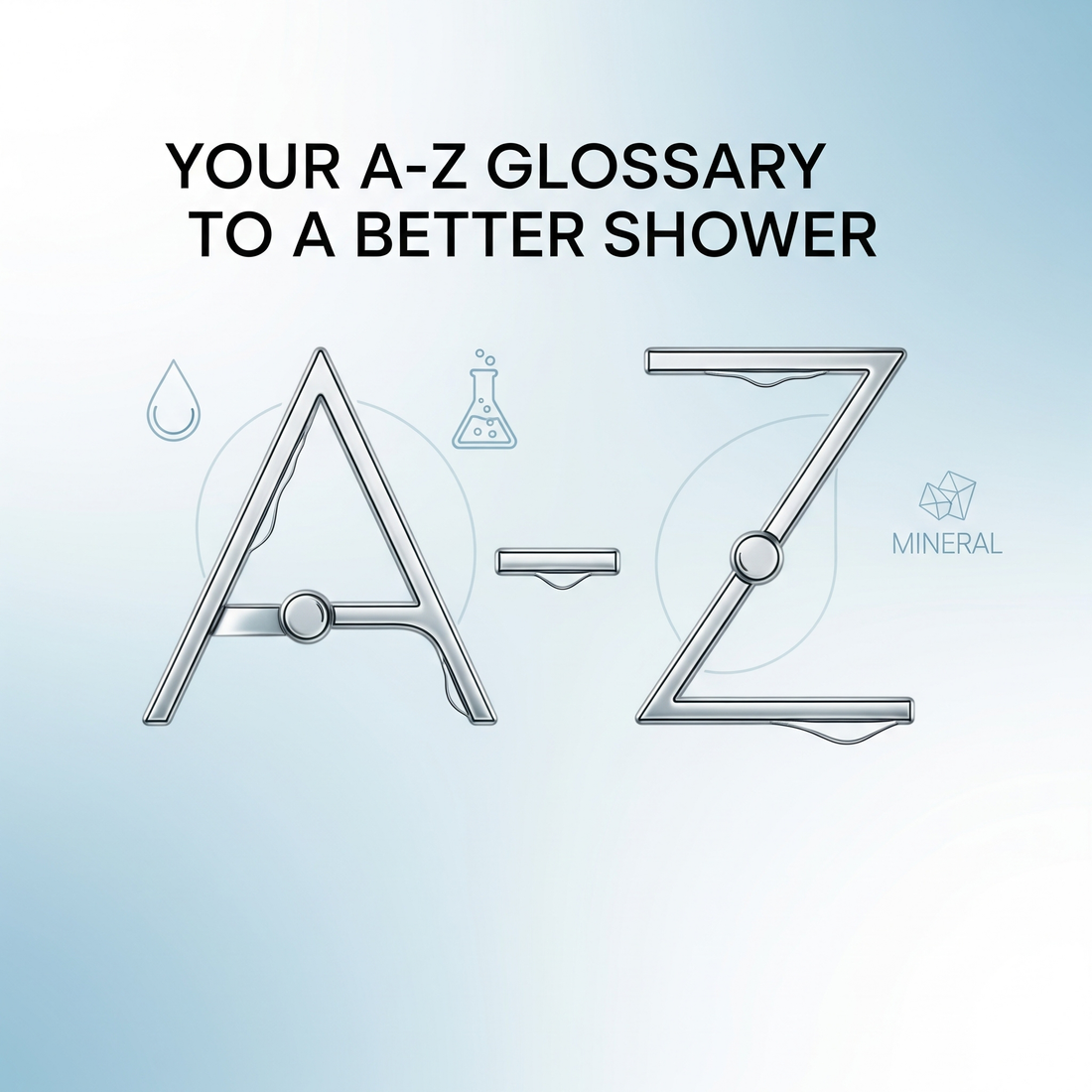
Hard Water, Heavy Metals & KDF-55: Your A-Z Glossary to a Better Shower
Share
Ever stepped out of the shower with your skin feeling tight, your hair dull, or your scalp itchy? The culprit might be lurking in your water supply. Understanding the science behind your tap water is the first step toward healthier skin and hair. Let's demystify the technical terminology with this comprehensive glossary of water quality terms that affect your daily shower experience.
The Hidden Chemistry in Your Daily Shower
When we turn on our showerheads, we're exposing ourselves to more than just water. Municipal water systems, while generally safe for consumption, contain various chemicals and minerals that can wreak havoc on our skin and hair over time. The microscopic battle happening on your skin during each shower can lead to persistent beauty concerns that expensive products alone can't solve.
Many of us invest in premium skincare and haircare products, yet continue to struggle with issues like dryness, acne, dandruff, and color fading. The missing piece of this puzzle often lies in what's flowing through your pipes.
The Serei Purifying Showerhead offers a practical solution to these water quality concerns. Its innovative two-stage filtration system effectively removes chlorine, reduces heavy metals, and mitigates the effects of hard water – addressing the root causes of many skin and hair problems. By filtering out these harmful elements before they reach your body, you can experience noticeably softer skin, healthier hair, and relief from irritation.
Your A-Z Glossary of Water Filtration Terms
Activated Carbon
Activated Carbon is a highly porous material that acts like a sponge, making it excellent at adsorbing a wide range of organic compounds and chemicals that cause bad tastes and odors. While it is a fantastic filtration agent, its effectiveness at removing chlorine can diminish significantly in the hot water and high flow rates of a typical shower. For this reason, it is not as effective as KDF-55 and Calcium Sulfite, which excel at chlorine removal under these exact conditions.
Calcium Scale
The chalky white residue that accumulates on shower fixtures and glass doors. This buildup results from calcium minerals in hard water and can also form on your hair and skin, leading to dullness and irritation over time.
Calcium Sulfite
This is one of the most efficient materials for removing chlorine and chloramine from water. While other media can lose their effectiveness in hot water, calcium sulfite excels at higher temperatures, making it a crucial ingredient for a high-performing shower filter. Its primary role is to ensure chlorine is stripped from your water even in a long, hot shower, protecting your hair and skin when they are most vulnerable.
Chloramine
A disinfectant formed by combining chlorine with ammonia, increasingly used by water treatment facilities as an alternative to chlorine. Chloramine is more stable than chlorine but can be even more irritating to sensitive skin and may contribute to respiratory issues when inhaled as steam.
Chlorine
A chemical element added to public water supplies as a disinfectant to kill harmful bacteria and pathogens. While essential for public health, chlorine strips natural oils from hair and skin, commonly causing dandruff, itchiness, dryness, irritation, and exacerbating conditions like eczema and psoriasis.
"The average person absorbs more chlorine during a 10-minute shower than by drinking eight glasses of the same water."
— American Journal of Public Health
Hard Water
Water with high mineral content, particularly calcium and magnesium ions. Hard water makes soap less effective, leaves residue on skin and hair, and can exacerbate conditions like eczema while contributing to frizzy hair and color fading.
Heavy Metals
Metallic elements like lead, mercury, copper, and iron that may be present in tap water. These contaminants can enter water through aging pipes and infrastructure, potentially causing health concerns and damaging hair color when present in shower water.
KDF-55
Kinetic Degradation Fluxion, a copper-zinc filtration medium that uses a redox reaction to remove chlorine, heavy metals, and control microorganisms. This premium filtration material is more effective at higher temperatures, making it ideal for shower water filtration.
Limescale
A hard, chalky deposit primarily consisting of calcium carbonate that forms when hard water evaporates. Limescale can clog showerheads, reducing water pressure and efficiency while also building up on hair follicles and skin cells.
pH Balance
A measure of how acidic or alkaline water is, with 7 being neutral. Water with unbalanced pH can disrupt your skin's natural protective barrier (typically pH 4.5-5.5), potentially leading to dryness, irritation, and accelerated aging.
Sediment
Particulate matter like dirt, rust, and sand suspended in water. These particles can physically abrade skin and hair, clog pores, and reduce the effectiveness of skincare and haircare products.
Volatile Organic Compounds (VOCs)
Carbon-containing chemicals that easily evaporate at room temperature and may be present in water supplies. When heated during showering, VOCs can be inhaled as steam and potentially cause respiratory irritation and other health concerns.
Summary
Understanding these terms empowers you to make informed decisions about your water quality. By addressing these invisible challenges, you can finally achieve the skin and hair results you've been seeking, regardless of how premium your beauty products may be.
